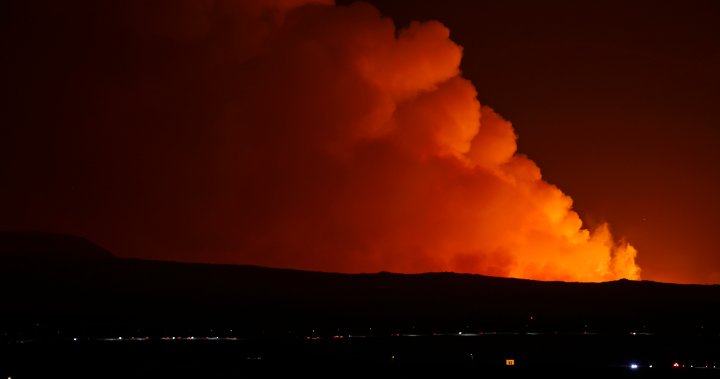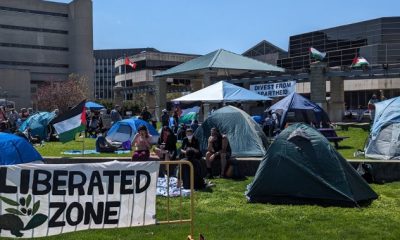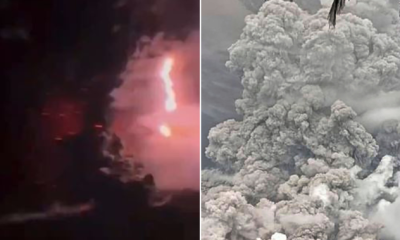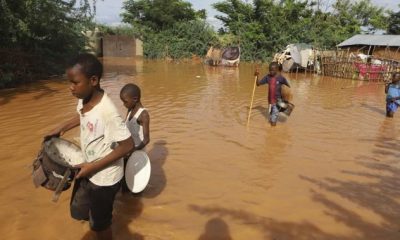General News
IN PHOTOS: Icelandic volcano erupts after weeks of activity, evacuations – National

A volcano erupted late on Monday in southwest Iceland, spewing lava and smoke across a wide area after weeks of intense earthquake activity, the country’s Meteorological Office said, threatening a nearby town.
Fearing a significant eruption on the Reykjanes peninsula, authorities last month evacuated the nearly 4,000 inhabitants of the fishing town of Grindavik and closed the nearby Blue Lagoon geothermal spa.
“Warning: Eruption has started north of Grindavik by Hagafell,” the Met Office said on its website, noting that the eruption began only a few kilometres from the town and cracks in the ground stretched toward the village located about 40 km (25 miles) south-west of Iceland’s capital city Reykjavik.
Reykjavik’s nearby Keflavik International Airport remained open, albeit with numerous delays listed for both arrivals and departures.
Images and livestreams of the eruption shown by Reuters and others showed molten rock spewing spectacularly from fissures in the ground, their bright-yellow and orange colours set in sharp contrast against the dark night sky.
“Seismic activity together with measurements from GPS devices indicate that the magma is moving to the southwest and the eruption may continue in the direction of Grindavik,” the Met Office said.
The eruption of a volcano on the Reykjanes peninsula of south-west Iceland is viewed in this still image from a livestream video.
Reuters/Live From Iceland

The eruption of a volcano on the Reykjanes peninsula of south-west Iceland is viewed in this webcam image.
Iceland Meteorological Office
The crack in the earth’s surface was around 3.5 km long and had grown rapidly, it added.
Some 100 to 200 cubic metres (3,530 to 7,060 cubic feet) of lava emerged per second, several times more than in previous eruptions in the area, the Met Office said.
Get the latest National news.
Sent to your email, every day.
Local police said they had raised their alert level as a result of the outbreak and the country’s civil defence warned the public not to approach the area while emergency personnel assessed the situation.
Located between the Eurasian and the North American tectonic plates, among the largest on the planet, Iceland is a seismic and volcanic hot spot as the two plates move in opposite directions.
The most disruption in recent times was the 2010 eruption of the Eyjafjallajokull volcano, which spewed huge clouds of ash into the atmosphere and grounded flights across Europe for days because of fears ash could damage airplane engines.
Scientists say a new eruption would likely produce lava but not an ash cloud.
The night sky is illuminated caused by the eruption of a volcano on the Reykjanes peninsula of south-west Iceland seen from the capital city of Reykjavik, Monday Dec. 18, 2023. (AP Photo/Brynjar Gunnarsson).
People watch as the night sky is illuminated caused by the eruption of a volcano on the Reykjanes peninsula of south-west Iceland seen from the capital city of Reykjavik, Monday Dec. 18, 2023. (AP Photo/Brynjar Gunnarsson).
But eruptions are still hard to predict. In mid-November, Grindavik inhabitants were whisked from their homes in the middle of the night as the ground shook, roads cracked and buildings suffered structural damage.
Seismologists believed at the time an eruption was imminent, but the geological activity later eased.
The Reykjanes peninsula in recent years saw several eruptions in unpopulated areas.
In March 2021, lava fountains erupted from a fissure in the ground measuring between 500 to 750 metres (1,640 to 2,460 feet) long in the region’s Fagradalsfjall volcanic system.
Volcanic activity in the area continued for six months that year, prompting thousands of Icelanders and tourists to visit the scene. In August 2022, a three-week eruption happened in the same area, followed by another in July of this year.

Source
Disclaimer: No copyright infringement intended. All rights and credits reserved to respective owner(s).


























